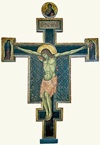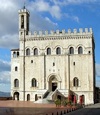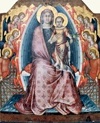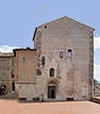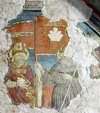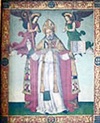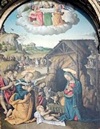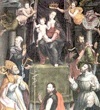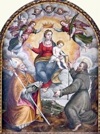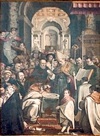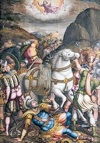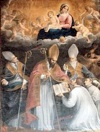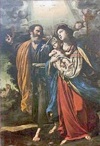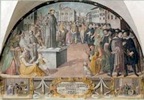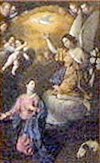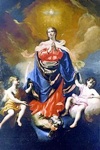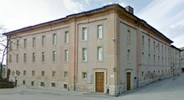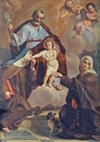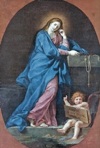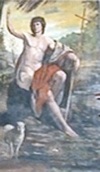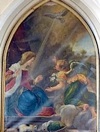

Oderisi da Gubbio (13th century)
From Gubbio
This miniaturist is known primarily from literary references in Dante’s “Divine Comedy” (ca. 1320) and in Giorgio Vasari’s “Lives of the Painters, Sculptors and Architects” (1568). The latter places Oderisi in Rome in ca. 1303, working in the library of Pope Benedict XI. Surviving documents place him in Bologna in 1268-71. Unfortunately, no works that can be securely attributed to him survive.
Maestro della Croce di Gubbio (ca. 1300)
This Crucifix (ca. 1300) in the Pinacoteca, Gubbio, which is of unknown provenance, is the autograph work of the Maestro della Croce di Gubbio. A fresco (ca. 1300) of the Crucifixion with the Virgin and SS John the Evangelist, James and Marianus in the Palazzo delle Canoniche is also attributed to him.
Maestro Espressionista di Santa Chiara/ Palmerino di Guido (early 14th century)
Probably from Umbria
The following works in Gubbio are attributed to the Maestro Espressionista di Santa Chiara:
-
✴the frescoes (ca. 1320) in the lower part of the right apsidal chapel of San Francesco;
-
✴a large detached fresco (early 14th century) of the Madonna and Child with angels in the Museo Diocesano, which is is from Santa Maria dei Laici;
-
✴a painted Crucifix (early 14th century) of unknown provenance in the Pinacoteca Civica;
-
✴a painted panels (early 14th century) of a wooden sarcophagus (13th century) in Sant’ Ubaldo that once held the relics of St Ubaldus; and
-
✴fresco fragments from a Last Judgement in San Secondo.
[Temporary link to the Maestro Espressionista di Santa Chiara]
Fra Bevignate (died after 1306)
Probably from Cingoli, based in Perugia
Fra Bevignate was Director of Works in Perugia for some 30 years until his death. In Gubbio, local tradition attributes the construction of San Francesco (1259-92) to him, although there is no documentary support for this hypothesis.
[Temporary link to Fra. Bevignate]
Angelo da Orvieto (died after 1337)
Angelo probably trained under Lorenzo Maitani, who was capomaestro of the Duomo, Orvieto from 1310. No work in his native city is attributed to him. Inscriptions on the portal (1332-7) of Palazzo dei Consoli, Gubbio record his association with its design and construction.
Guiduccio Palmerucci (1280-ca.1345)
From Gubbio
Mello da Gubbio (died ca. 1360)
The signature “Opus Melli de Eugubio” was discovered in 1979 on this panel (14th century) in the Museo Diocesano, which came from the Pieve d’ Agnano. Since then, a number of works in or near Gubbio that were previously attributed to Guiduccio Palmerucci (above) have been reattributed to him.
Matteo di Giovannello, il Gattapone (died after 1374)
Il Gattapone was documented as “mensurator e geometra” in relation to the construction of the Palazzo del Podestà (1349), illustrated here. His precise role, here as elsewhere, is a matter of debate. The design of Palazzo dei Consoli (1322-42) is sometimes attributed to him, but this is unlikely. He went on to be associated with papal projects across Umbria, the most important of which was the Rocca di Spoleto. A “magistro Mactheo” is documented in Gubbio in 1380-3. This is usually thought to refer to il Gattapone, who probably died of plague in 1383.
Taddeo di Bartolo (died 1422)
From Siena
Part of a panel (early 15th century) of St Clare in the Museo Diocesano is attributed to Taddeo di Bartolo.
[Temporary link to Taddeo di Bartolo]
Lorenzo and Jacopo Salimbeni (early 15th century)
From San Severino
All of the surviving she signed works of Lorenzo Salimbeni were executed in the period 1400-16 in the area around his native city. Two of these were signed additionally by his younger brother, Jacopo, but no securely documented work by Jacopo alone is known. A fresco (early 15th century) of St Michael in Santa Maria Nuova is attributed alternatively to Lorenzo or Jacopo Salimbeni.
[Temporary link to Lorenzo and Jacopo Salimbeni]
Ottaviano Nelli (1375 - ca. 1450)
Ottaviano Nelli was the grandson of Mello da Gubbio (above). A number of works by or attributed to him survive in his native Gubbio, including this fresco (1413) known as the Madonna del Belvedere in Santa Maria Nuova.
Giacomo di Benedetto Bedi (died after 1475)
Probably from Gubbio
Giacomo di Benedetto Bedi was a follower of Ottaviano Nelli (above). He signed the frescoes (1457) of the Cappella di San Sebastiano of San Secondo. Other frescoes (15th century) are attributed to him in Santa Maria dei Laici and San Domenico.
[Temporary link to Giacomo di Benedetto Bedi]
Giuliano da Maiano (1432-90)
From Maiano, near Fiesole, based in Florence
Giuliano da Maiano, who was among the leading architects and sculptors of Florence in the 15th century, is particularly known for his woodcarving and intarsia work. The intarsia panels (ca. 1475-82) of the studiolo of Duke Federico da Montefeltro in Palazzo Ducale, Gubbio are (like those of the equivalent room in Palazzo Ducale, Urbino) attributed to him.
[Temporary link to Giuliano da Maiano]
Bernardino di Nanni dell’ Eugenia (died after 1495)
Probably from Gubbio
Text
[Temporary link to Bernardino di Nanni]
Orlando Merlini (died 1510)
This artist is known from four signed works in 1501-7 from small towns u=in Umbria and the Marches. Works in Gubbio that are attributed to him include:
-
✴a fresco (late 15th century) of the Madonna and Child with angels in San Secondo (which is attributed alternatively to Bernardino di Nanni dell’ Eugenia - above);
-
✴a fresco (ca. 1500) of the Crucifixion in the apse of Santa Maria della Vittoria;
-
✴a fragment of a fresco (ca. 1500) known as the Maestà del Voltone in Palazzo Ducale; and
-
✴a fresco fragment (ca. 1503) depicting SS Ubaldus and Augustine on the wall of the Sala d’ Arengo of Palazzo dei Consoli (illustrated here).
Mariotto di Paolo Sensi, il Terzuolo (died 1547)
From Gubbio
The life of il Terzuolo in Gubbio is extensively documented, but only one securely attributed example of his work as a wood carver survives: the furniture (1494-7) on the right wall of the sacristy of the Duomo of Perugia. A documented organ casing (1495) for Santa Maria dei Laici no longer survives. A pair of carved doors in Palazzo Ducale are attributed to him.
[Temporary link to Mariotto di Paolo Sensi, il Terzuolo]
Sinibaldo Ibi (died after 1548)
Sinbaldo Ibi belonged to the so-called workshop of 1496 in Perugia. Two of his works survive in Gubbio:
-
✴a processional banner (1503) from Santa Spirito (is now in the Pinacoteca) depicting Madonna della Misericordia on one side and St Ubaldus (illustrated here) on the other,; and
-
✴an altarpiece (1507) of the Madonna and Child with SS Sebastian and Ubaldus, which remains in its original location in the Duomo.
Pietro Paolo Baldinacci (died after 1549)
From Gubbio
Two documented works by Pietro Paolo Baldinacci are known in Gubbio:
-
✴a processional standard (1517-21) in Santa Croce della Foce, which he executed with the otherwise unknown “maestro Silvio”; and
-
✴the painted panels (ca. 1459) of the organ casing on the right in the Duomo, which he executed with his son-in-law, Benedetto Nucci (below).
[Temporary link to Pietro Paolo Baldinacci]
Giorgio Andreoli (died 1553)
Giorgio di Pietro Andreoli (Mastro Giorgio) perfected the technique of lusterware and built a successful business on the back of it. Four works from his workshop are now in Gubbio:
-
✴two in the the Museo della Ceramica (part of the Museo Civico):
-
•a plate (1527) signed by Mastro Giorgio that depicts the Fall of Phaeton, which was purchased in 1992 (illustrated here) ; and
-
•a plate [signed?] by Francesco Xanto Avelli and Master Giorgio that depicts the fable of Circe, Picus and Canens (1528), which was purchased in 1996; and
-
✴two in the the Museo della Maiolica a Lustro:
-
• a plate (1537) signed by Mastro Giorgio that depicts the rape of Persephone; and
-
•St Antony of Padua [details?].
Giuliano Presutti (1490-1554)
The documented Gonfalone della Misericordia (1533-4) by Giuliano Presutti from Santa Maria dei Laici is now owned by Finch College, New York. A number of other works in Gubbio attributed to him:
-
✴two altarpieces in the Duomo:
-
•the altarpiece (ca. 1521) of the Adoration of the Shepherd (illustrated here);
-
•altarpiece (ca. 1526-9) of St Mary Magdalene;
-
✴the altarpiece (16th century) of the Assumption of the Virgin from the the Pieve di Valdichiascio, which is now in the Museo Diocesano; and
-
✴the altarpiece (16th century) of the Communion of the Apostles in San Domenico.
Raffaellino del Colle (1490-1556)
From Colle, Borgo Sansepolcro, moved to Città di Castello in 1527
Raffaellino del Colle probably trained under Giovanni di Pietro, lo Spagna. He was working in the Vatican in 1520, immediately after the death of Raphael, and might have worked there earlier with Raphael himself. His stay in Rome lasted until 1524, after which he worked in Umbria, Tuscany and the Marches. In Gubbio, he decorated the Cappella di San Benedetto of San Pietro in 1539-40.
[Temporary link to Raffaellino del Colle]
Giorgio Vasari (1511-74)
From Arezzo, based from 1527 in Florence
Although he is mainly remembered as an art historian, Giorgio Vasari was also a prolific painter and architect who enjoyed the patronage of the Medici of Florence throughout his career. He designed a tabernacle for the high altar of San Pietro in 1555: it was completed by Girolamo and Giacomo Maffei (below) in 1561 but destroyed in 1680.
[Temporary link to Giorgio Vasari]
Dono Doni (1505-75)
From Assisi
Dono Doni was perhaps the pre-eminent Umbrian-born painter of the late Renaissance. Two works in in the Duomo of Gubbio are by or attributed to him:
-
✴the signed altarpiece (ca. 1564) depicting the Way to Calvary; and
-
✴the altarpiece (after 1560) of the Pietà (attributed).
[Temporary link to Dono Doni]
Girolamo Danti (1547-80)
From Perugia
Girolamo Danti was the younger brother of two famous Perugians: the Dominican mathematician Ignazio and the sculptor Vincenzo. A panel (ca. 1575) of the Adoration of the Shepherds in San Domenico is attributed to him.
[Temporary link to Girolamo Danti]
Benedetto Nucci (died after 1596)
Benedetto Nucci was perhaps the most prolific artist in Gubbio for much of the 16th century. This altarpiece (1570) of the Madonna and Child with saints in the Duomo, which is signed and dated, is typical of his work.
Maffei Family (16th century)
From Gubbio
Several generations of this family of wood carvers worked in Gubbio in the 16th century. [More]
[Temporary link to Maffei Family]
Giovanni Maria Baldassini (1540-1601)
Giovanni Maria Baldassini was a follower of Felice Damiani. [More] This altarpiece (1597) in Santa Maria della Vittoria, which depicts the Madonna and Child with saints, is attributed to him.
Felice Damiani (died after 1609)
Felice Damiani executed a number of works in his native city in the period from ca. 1594 until his death. They include this altarpiece (1594) of the baptism of St Augustine, which he painted for his own family chapel in Sant’ Agostino.
Virgilio Nucci (1545-1621)
Virgilio Nucci, who trained under his father Benedetto (above), began his independent career in ca. 1569. A large corpus of work in Gubbio is by or attributed to him. This altarpiece (1596) of the Conversion of St Paul in the Duomo, [which is signed and dated by inscription,] is typical of his work.
Avanzino Nucci (died 1629)
Avanzino Nucci was a follower of of Nicolò Circignani, il Pomarancio:
-
✴This panel (1604) in Sant’ Ubaldo. which depicts St Augustine gives a rule to the Augustinians, is attributed to him.
-
✴So too are eight scenes (1604) from the life of St John the Baptist in San Giovanni Decollato.
Benedetto Bandiera (1557-1634)
From Perugia
Benedetto Bandiera signed an altarpiece (17th century) in San Francesco, which depicts the Madonna and Child with SS Bonaventure, Clare and Charles Borromeo.
[Temporary link to Benedetto Bandiera]
Rutilio Manetti (1571- 1639)
Rutilio Manetti worked mostly in his native city. Two works in Gubbio carry his signature:
-
✴an altarpiece (1634) of the Flight into Egypt from Santa Maria Nuova, which is now in the Pinacoteca Civica (illustrated here); and
-
✴an altarpiece (1634) of the Martyrdom of St Bartholomew in San Pietro.
Other works (17th century) in Gubbio that are attributed to him include:
-
✴panels of St Onofrius and St Francis in San Pietro;
-
✴an altarpiece of St Peter Martyr from San Domenico, which is now in the Museo Diocesano; and
-
✴an altarpiece of St Francis of Paola in Santa Maria della Piaggiola.
Giovanni Baglione (1573-1644)
From Rome
Giovanni Baglione was an important painter in Rome and an art historian. He is best remembered for his biographies of his contemporary artists. An altarpiece (1612) of St Mary Magdalene in San Domenico [dated by inscription ?] is by/attributed to him.
[Temporary link to Giovanni Baglione]
Federico Brunori (1566-1649)
From Gubbio
The earliest known work by Federico Brunori is a panel (1597) of the Ecce Homo in San Giovanni Decollato, which is signed and dated by inscription. Other works in the city that are attributed to him include:
-
✴a panel (1596) of the Immaculate Conception in the Monastero delle Cappuccine, [which is dated by inscription ??], which is alternatively attributed to Virgilio Nucci (above); and
-
✴a fresco (1612) of St Francis and the Wolf of Gubbio (illustrated above), which is dated by inscription, and which survives in situ on the entrance wall of the Sala dell' Udienza of Palazzo dei Consoli (now Room V of the Pinacotecta Comunale).
Giovanni Battista Michelini (died 1679)
From Foligno
Francesco Allegrini (1624-84)
Francesco Allegrini established his career in Rome. His first works in Gubbio were the frescoes (1652-4) Bishop Alessandro Sperelli commissioned for Cappella del Santissimo Sacramento of the Duomo (including this fresco of the Coronation of the Virgin in the cupola). He executed other works in the city at this time, and many more in the period 1661-81. This latter group includes frescoes (1674-8) in Santa Maria del Prato, which Bishop Alessandro Sperelli commissioned in 1669.
Antonio Gherardi (1638-1702)
Antonio Gherardi (born Antonio Tatoti) trained in Rome as a painter and architect under Pietro da Cortona in 1662-7. A number of works by or attributed to him survive in Gubbio, including this panel (1693) of the Immaculate Virgin in San Francesco.
Giuseppe Nicola Nasini (d. 1736)
From outside Siena
Giuseppe Nicola Nasini trained in Rome but subsequently worked mostly in Siena. An altarpiece and four other panels in San Pietro were attributed to him, but two of these have been lost. The three surviving panels comprise:
-
✴an altarpiece of the Madonna and Child enthroned with Blessed Bernard Tolomei;, which is now now on the 2nd altar on the right; and
-
✴two panels in the left transept depicting:
-
•the Deposition; and
-
•the road to Calvary.
[Temporary link to Giuseppe Nicola Nasini]
Louis Dorigny (1654-1742)
Born in Paris, trained in Rome in 1671-5, based in the Veneto from ca. 1680
Louis Dorigny, who was the grandson of painter Simon Vouet, seems to have worked in Umbria in ca. 1675-80, before establishing a successful career in Venice and then Verona. Works in Gubbio that are by or attributed to him include:
-
✴the altarpiece (1677) of the Madonna and Child with St Trophimus in Santa Croce della Foce; and
-
✴a number of frescoes (1677-8) in Santa Maria del Prato, where he probably worked as an assistant to Francesco Allegrini (above).
[Temporary link to Louis Dorigny]
Giacinto Boccanera (1666-1746)
From Leonessa; trained in Rome; based in Perugia
The altarpiece (17th century ?) on the high altar of San Filippo Neri, which depicts St Philip Neri converting to Jews to Christianity, is attributed to Giacinto Boccanera.
[Temporary link to Giacinto Boccanera]
Carlo Murena (1713-64)
From Collalto Sabino, based in Rome
Carlo Murena trained as an architect in Rome under Luigi Vanvitelli (below), and later looked after Vanvitelli’s practice in Rome. The design (1746) for the new hospital (1749-66) of Gubbio was commissioned from him and his associate, Antonio Francesco Berardi di Cagli.
Sebastiano Conca (1680–1764)
From Gaeta; based in Rome in 1706-52
Sebastiano Conca was one of the leading artists in Rome in the early 18th century. The altarpiece (18th century) of St Francis’ Vision of Christ in San Benedetto is attributed to him.
[Temporary link to Sebastiano Conca]
Gaetano Lapis (1704-76)
From Cagli, based mostly in Rome
Gaetano Lapis trained under Sebastiano Conca (above) in Rome the 1720s and subsequently established a successful career there. Works in Gubbio that are by or attributed to him include:
-
✴a small panel of St Benedict (probably 1733) above the altarpiece on the high altar of San Benedetto;
-
✴an altarpiece (1734) of St Francis of Paola in Santa Maria del Prato;
-
✴an altarpiece (18th century) of St Lucy in Glory in Santa Lucia; and
-
✴an oval panel (18th century of St Francis in the Chiesa della Misericordia.
[Temporary link to Gaetano Lapis]
Giuseppe Reposati (1722-99)
Giuseppe Reposati , who trained in Rome under Gaetano Lapis (above), subsequently worked mostly in his native city. His surviving works in Gubbio include this altarpiece (18th century) in SS Trinità, which depicts SS Joseph, Clare and Margaret of Cortona.
Tommaso Conca (1734-1822)
Tommaso, Conca who trained under his relation Sebastiano Conca (above), became a leading painter in Rome. This altarpiece (18th century) of Santa Maria Addolorata in Sant’ Ubaldo bears his signature. It also bears the date 1789, but this is probably the date of its installation in its present location: stylistic considerations suggest that it was painted some decades earlier.
Annibale Beni (1764-1845)
Annibale Beni established his career in Rome, before returning to his native city in 1816. His surviving works here include:
-
✴two panels painted in Rome in ca. 1797:
-
•the Blessed Arcangelo Arcangelo Canetoli in prayer, on the high alter of the Eremo di Sant’ Ambrogio; and
-
•Blessed Leonard of Porto Maurizio, for the Capuchins of the Convento di San Girolamo (now in the deposit of the Pinacoteca Comunale); and
-
✴frescoes (1828-9) in the baptistery of San Giovanni Battista, which include this depiction of St John the Baptist in the desert.
Camilla Filicchi (1771 - 1848)
Works in Gubbio by or attributed to Camilla Filicchi include:
-
✴a panel (1816) of the Stigmatisation of St Francis in Sant’ Ubaldo;
-
✴three works in San Giovanni Battista:
-
•two panels (1830) in the baptistery that depict:
-
-St Elizabeth and the young St John the Baptist; and
-
-St Ubaldus beside an altar upon which stands the reliquary of the finger of St John the Baptist; and
-
•an altarpiece (19th century) of the Annunciation (illustrated here); and
-
✴a panel (19th century) in the Duomo that depicts the patron saints of Gubbio entrusting the city to the protection of the Virgin.
Return to the home page on Gubbio.
